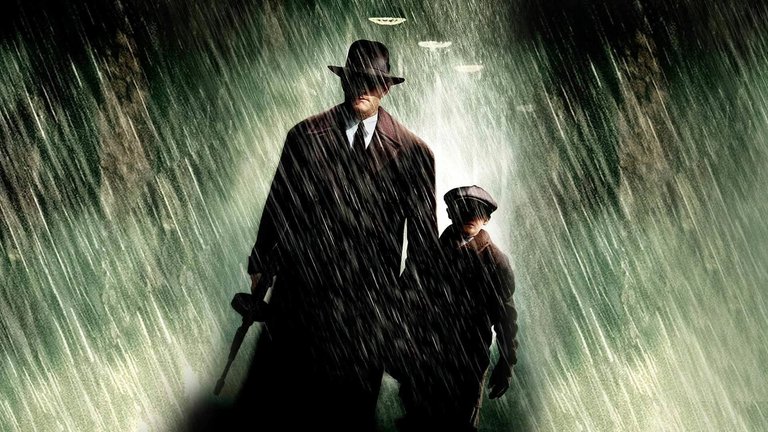Film Review: Road to Perdition (2002)

Before Marvel and DC became the only relevant sources of content for Hollywood, smaller comic book houses provided the same service through graphic novels, many of which resulted in interesting films. Graphic novels, by their nature, were very convenient as storyboards for future film adaptations, but this often reflected in style and atmosphere being more important than story and characters. Road to Perdition, 2002 period gangster drama directed by Sam Mendes, represents a good example of this phenomenon.
The film is based on the 1999 graphic novel by Max Allan Collins and Richard Piers Rayner. The plot is set in 1931 Illinois and is narrated by Michael Sullivan Jr. (played by Tyler Hoechlin), 12-year old boy who, unlike most of his peers during Grand Depression, lives relatively comfortable life unaware how his beloved father Michael Sr. (played by Tom Hanks) provides for his family. Michael Sr. is actually top enforcer for Irish mob boss John Rooney (played by Paul Newman), a man whom he loyally and comptetently served for years and whose favour he has won, much to the chagrin of Rooney’s son Connor (played by Daniel Craig). When Michael Jr. accidentally discovers his father and Connor being involved in killings, Connor uses it as an excuse to take out his rival. Attempt fails, but Michael’s mother Annie (played by Jennifer Jason Leigh) and younger brother Peter (played by Liam Aiken) are killed. Boy and his father are forced to flee, with Michael Sr. using his deadly skills and connections in Chicago, ruled by Capone’s organisation and his lieutenant Frank Nitti (played by Stanley Tucci), not only to survive but to exact revenge against his former friend and mentor.
Road to Perdition was an ambitious project, directed by Sam Mendes, the British director who had triumphed at the Oscars with his feature debut, American Beauty. The film starred two highly respected Oscar-winning actors, Tom Hanks and Paul Newman. As such, it received modest success at the box office and mostly positive, but not too enthusiastic, reviews. Today, it is not considered one of the most remarkable films of its period.
The film undoubtedly received a large budget, with plenty of it being spent to depict Depression-era Chicago and America as accurately as possible through authentic props and costumes, and even some CGI when locations weren't available. Conrad B. Hall, the legendary cinematographer known for his work on The Godfather, provided a great atmospheric look, emphasizing the night, rain, and coldness that corresponds with the general bleakness of the story. Hall would posthumously win an Oscar for Best Cinematography for his work. One of the film's best scenes is when young Michael arrives in Chicago, and his sense of wonder is brought through a brilliant sequence where the great metropolis appears to rise out of the rural plains like the magical city of Oz. Sadly, nothing before and after that scene can match such brilliance.
The main problem with Road to Perdition is the script, which is at odds with whether to present the story as a morality tale, a character study, or an excuse for scenes of violence, which are, in line with the conformist principles of the early 21st century, much toned down compared to the novel. The characters, with the exception of John Rooney, torn between his Catholicism and the criminal path he has taken, and brilliantly played by the great Paul Newman in his last feature film role, are one-dimensional and waste the great talents of the actors playing them, including the rather bland Tom Hanks. Jude Law, on the other hand, tries too hard in the role of the hitman with a strange photographic fetish, making such a villainous character too cartoonish and too "out there," turning Road to Perdition into an unintentional parody of itself.
While Road to Perdition is watchable because of Newman's performance and the great visuals, it isn't a grand film, at least not as grand as it could have been. The film's ambition and the talent involved are evident, but the script's shortcomings prevent it from reaching the heights it aspires to.
RATING: 5/10 (++)
Blog in Croatian https://draxblog.com
Blog in English https://draxreview.wordpress.com/
InLeo blog https://inleo.io/@drax.leo
Hiveonboard: https://hiveonboard.com?ref=drax
Rising Star game: https://www.risingstargame.com?referrer=drax
1Inch: https://1inch.exchange/#/r/0x83823d8CCB74F828148258BB4457642124b1328e
BTC donations: 1EWxiMiP6iiG9rger3NuUSd6HByaxQWafG
ETH donations: 0xB305F144323b99e6f8b1d66f5D7DE78B498C32A7
BCH donations: qpvxw0jax79lhmvlgcldkzpqanf03r9cjv8y6gtmk9
Posted Using InLeo Alpha
Yeehaw! This blog post about "Road to Perdition" is a wild ride through the graphic novel adaptations in Hollywood. It praises the film's visuals and performances but critiques its script and character development. It's like a wild mustang, a bit untamed but still worth the ride! Keep on exploring those hidden gem adaptations and enjoying the cinematic journey, partner!
Looks interesting.. The film's portrayal of 1930s America, with its detailed attention to the aesthetics of the era, looks very good. thanks for sharing!